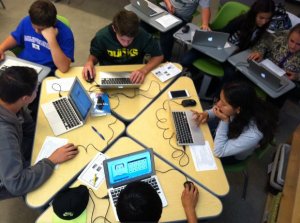End the Year with the Best. Final. Ever.

There’s no avoiding it; my 8th graders know that summer vacation is almost here. After all, they’ve been measured for their promotion gowns, they’ve posed for their panoramic class picture, they are wrapping up their final junior high projects, and their teachers are starting to collect textbooks. As the weather gets warmer, how do you keep students on task, engaged and, yes, even learning in the final days?
Our junior high semesters end with three days of finals: two classes per day, two hours for each class. Although I could create a semester final exam that would take my students two hours to complete, I don’t think that is the best use of our time (nor am I convinced that junior high students should be taking two-hour finals). It can be a challenge to find effective ways to fill that two-hour block of time, honoring both their excitement for summer and our responsibility as educators.
A few years ago I experimented with a collaborative, small group final project that students completed and presented to their peers within our final class period. It was such a success that now I use it every year, in both December and June. Anything that keeps teenagers focused for two hours, with winter break or summer right around the corner, is worth sharing. This is what I call my Best. Final. Ever.
My students enter the classroom and find the desks arranged in groups of four. They locate their seats by checking a list of teams projected onto the whiteboard. Once they settle in, I distribute the directions. One of my goals with this lesson is for them to read the directions and work together successfully; by this time in the year, they shouldn’t have to ask me for help.
Designated team leaders are given directions to create a new Slide presentation in their Google Drive, and then share it with their teammates (via gmail) and with me. Then each team works together to create a presentation about a universal theme. Using lines from a poem as a prompt, they identify one theme that is found in two novels, a movie, a poem, and a song that we studied this year, as well as how they see that theme in their own lives. Each team member is responsible for a couple slides of the presentation, which they will present together at the end of the class period.
A sign of success, right off the bat, is that the students get to work right away. Most are familiar with Google apps, so even if they haven’t used Slides before, they can figure it out. And while they demonstrate their knowledge of theme, they also show that they have learned how to create effective visual presentations: carefully choosing words for each slide, finding compelling symbolic images (that are labeled for reuse), inserting and citing the images, and creating a unified appearance from one slide to the next.
Once the teams complete their project, they present it to the class. I am impressed every year with how different each presentation is, even though the poem, novels, and movie are all the same. And while we often struggle to keep our students engaged at the very end of the school year, this two-hour final period seems to fly by. Added bonus for me? I assess them as they present, so I don’t end the semester with a pile of exams to grade.
What’s your secret for making the last few days of the school year engaging and worthwhile for your students? Please share in the comments below!